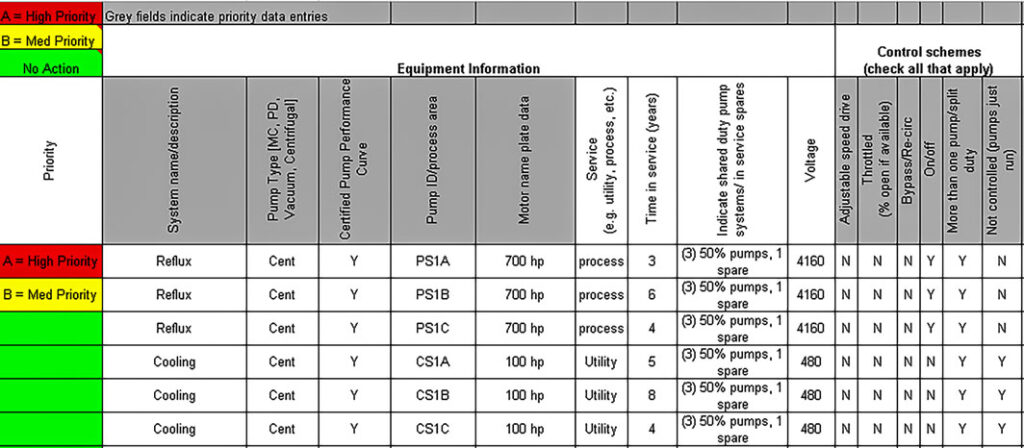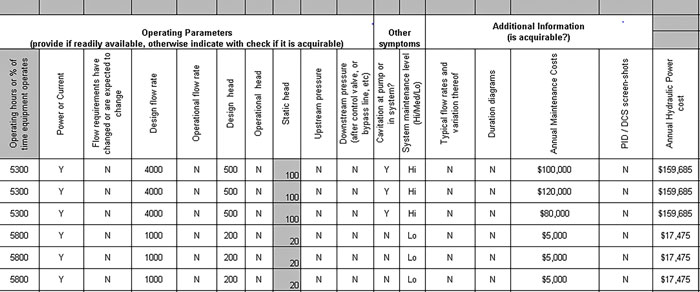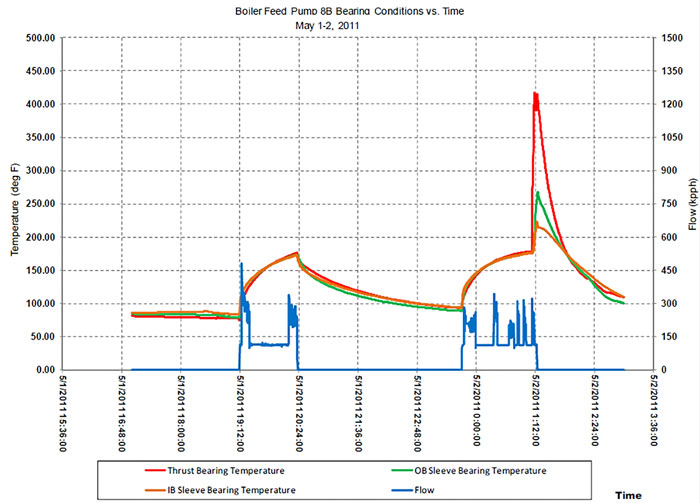A Guide to Pump System Assessment
When pump systems are not optimized, it impacts a facility’s bottom line with increased maintenance, lost production and higher energy costs. System optimization is a cost-effective way to improve reliability and reduce energy consumption while improving process control to meet the process requirements.
By Peter Gaydon & Edgar Suarez, Technical Affairs for the Hydraulic Institute
When pump systems are not optimized, it impacts a facility’s bottom line with increased maintenance, lost production and higher energy costs. System optimization is a cost-effective way to improve reliability and reduce energy consumption while improving process control to meet the process requirements. However, it is not always apparent what systems need optimization, and the expertise may not be available on staff to determine which systems need to be optimized or how to optimize them. A pump system assessment conducted by a qualified professional is the primary tool used to optimize a pumping system by identifying problematic areas where the greatest opportunities for improvement exist that will provide the greatest return on investment.
The pump system assessment process can be divided into four equally important, major tasks: pre-screening; development of the assessment team; detailed measurement, data gathering and analysis; reporting. Two more steps following the assessment are important, which are implementation of optimization recommendation, and measurement and verification.

To implement the assessment process properly, a plant needs to have a pump system optimization advocate that leads the assessment and optimization process. The advocate will communicate with management the opportunities and ensure their support, and will pull in the right plant personnel, equipment manufacturers and engineering consultants to make sure the desired outcome is achieved. Some OEMs, consulting and engineering firms offer comprehensive assessments.
The Hydraulic Institute created a Pump System Assessment Professional (PSAP) certificate program last year to test and certify individuals with extensive assessment experience.
Industrial plants can have thousands of pumps and hundreds of pumping systems, and system assessments require an investment of time and resources, so it is not wise or practical to assess all pumping systems or randomly select pumping systems for assessment. The best approach is to prescreen a plant’s pumping systems by gathering and analyzing some initial upfront information and data about a plant’s pumping system.
The prescreening determines the systems that are most in need of optimization and provides information to determine the level of assessment required to understand how to properly optimize the systems. Once the prescreening is complete, the optimization advocate has a ranked list of specific systems for further analysis that are likely to provide the most favorable return on the investment. HI offers free prescreening and modeling software tools at pumps.org/training.
Some typical prescreening data that will help prioritize opportunities include pump description, system history (unplanned failures, lost production, change in process, etc.), installed motor horsepower, yearly operational hours, control method, available instrumentation and maintenance records. The prescreening data is used to prioritize the systems with the highest operating and maintenance costs, followed by systems with known issues such as cavitation, change in duty, throttle control and frequent cycling.

From the prescreening, assessors should make a qualitative ranking of pumping systems with biggest savings potential, list the pump systems and solutions that can be implemented without detailed field analysis and list pump systems that need additional field analysis and determine the level of assessment required. Images 1 and 2 show an example of prescreening for some sample pumps. In part two of the prescreening form, there is an annual maintenance cost and annual cost of hydraulic power. Both of these provide an indication of the potential savings. These numbers—along with other system red flags—help prioritize the systems for assessment and optimization.
It is sometimes hard to justify assessments and optimization based on energy cost savings alone. Assessments are typically easier to justify by examining a combination of factors gathered during the prescreening, with unplanned failures resulting in system downtime, lost production, safety or environmental incidents, or high maintenance costs topping the list.
Once there is management approval to perform additional analysis, the assessment team will have to be developed. It is important that the assessment team have members with authority to allocate resources and coordinate logistics. The team structure should have a leader responsible for the overall outcome. This typically is the sponsor from the host organization. Moreover, qualified assessment engineers are needed in addition to specialists on system processes and functions, maintenance practice and history, and cost data.
Support of the facility management is important and the assessment should not go forward unless management supports its purpose and scope. The assessment team is responsible for communicating the business case to management when required.

The assessment team will need to review the available information and determine or confirm the assessment scope, boundary and level of assessment required. Three levels of assessment may be appropriate depending on the situation. A level 1 assessment is a qualitative review or paper audit. A level 2 assessment is a quantitative review based on steady-state operating conditions requiring limited infield measurements. A level 3 assessment is a quantitative review of a variable system that requires measuring data over a time span long enough to characterize the various operating conditions.
In systems with little or no variability, a level 2 assessment may be used to determine savings potential and optimization recommendation. In this level of assessment, the team will gather the appropriate data taken from plant information systems or by using portable measuring devices, giving a snapshot of conditions at the time of measurement.
In varying systems with high priority, a level 3 assessment may be used. In this level of assessment, a more complex investigation is conducted over an extended period of time sufficient to develop a system load profile. More extensive use of monitoring and a more complex data analysis are associated with this level of assessment. Detailed component failure analysis and/or hydraulic system modeling is often part of these assessments.
For example, if unexpected bearing failures are an issue, a detailed analysis of the bearing temperature in combination with system operating conditions along with an inspection of the failed bearings may be required. Image 3 shows a trend of bearing temperatures for a boiler feed pump prior to unexpected failures that was gathered from plant historical data as part of a level 3 assessment (see page 78). Once the appropriate field data is gathered, it is analyzed and optimization opportunities are identified.
Performance improvements generally fall into five categories: eliminate unnecessary uses, improve operations and maintenance practices, improve piping configuration, consider alternative pump configurations or design improvements and change pump control. An unnecessary use is putting more energy into the system than is required to meet the design. For example, operating a pump in recycle when no demand is needed, or running two pumps when only one is needed. You may need to improve operating procedures and improve controls to eliminate unnecessary use. It is important to have proper operating procedures so that pumps can be reliably switched and so that components of the pump do not fail. The assessment team needs to ensure proper procedures are in place and they are being followed.
Improving piping configuration is another method to improve performance since piping velocity is proportional to energy consumption. For existing installations, it is typically not practical to justify larger pipe; however, it should be considered and optimized for new installations. Suction piping is of utmost importance to ensure pump reliability. Make sure that installations are in compliance with industry standards ANSI/HI 9.6.6 Rotodynamic Pumps for Pump Piping and 9.8 Rotodynamic Pumps for Pump Intake Design and the net positive suction head (NPSH) margin is in accordance with ANSI/HI 9.6.1 Rotodyanmic Pumps – Guidelines for NPSH margin.
Considering alternative pump system configurations is another option to improve performance. Depending on the fluid being pumped, replacing a currently installed centrifugal pump with a positive displacement pump may be warranted. Using smaller sized pumps or installing multiple pumps in parallel or series along with trimming or installing new impellers may improve system performance.
Using proper control of the system, such as level, temperature, pressure and flow controls, is one of the most important considerations to ensure the system demand is met and the system operates optimally.
Another option is implementing variable speed control, which reduces the speed based on a feedback (such as pressure or level) to meet demand, reduces mechanical stresses, and allows for soft starting and stopping.
Energy savings are important, but as mentioned previously, in many cases the nonenergy benefits outweigh the energy benefits. Some of these nonenergy benefits include higher reliability, increased productivity, less equipment wear and tear, reduced maintenance costs, reduced production losses, increased capacity utilization, reduced environmental impact and improved safety.
Most of the time, a system assessment is conducted because of failures or reliability issues. Recommendations in the assessment report should address these issues and calculate life cycle cost impacts. It is important to economically validate the optimization opportunities.
Once an assessment is completed, the results should be documented and reported to the management team. The report and other documentation delivered with the report should include sufficient raw data from the assessment so that the analyses performed can be confirmed by a third party. This documentation should be structured so it can be easily accessed by verifiers and other people not involved in its development.
The final assessment report should include the following sections: executive summary, introduction including facility information, assessment objectives and scope, description of systems studied and systems deficiencies, assessment data collected, data analysis, annual baseline costs of operation, maintenance, downtime, production loss, prioritized performance improvement opportunities, implementation steps and data appendices. This report format provides an effective summary in the beginning for management and the background and detailed analysis required to justify the recommendations.
There is a great opportunity for system optimization that is enabled by a pump system assessment. This article covered what is required of a pump system assessment and the process of developing the assessment team and implementing the assessment. It is important to economically validate the optimization opportunities and effectively report the assessment results.
The presentation of the report should be tailored to the purpose of the assessment, which may take different forms depending on the reason for the assessment and the personnel being presented to.
This article was originally printed in Pump & Systems Magazine, 08/30/2018.
SUBSCRIBE TODAY
Get the latest pump industry news, insights, and analysis delivered to your inbox.
